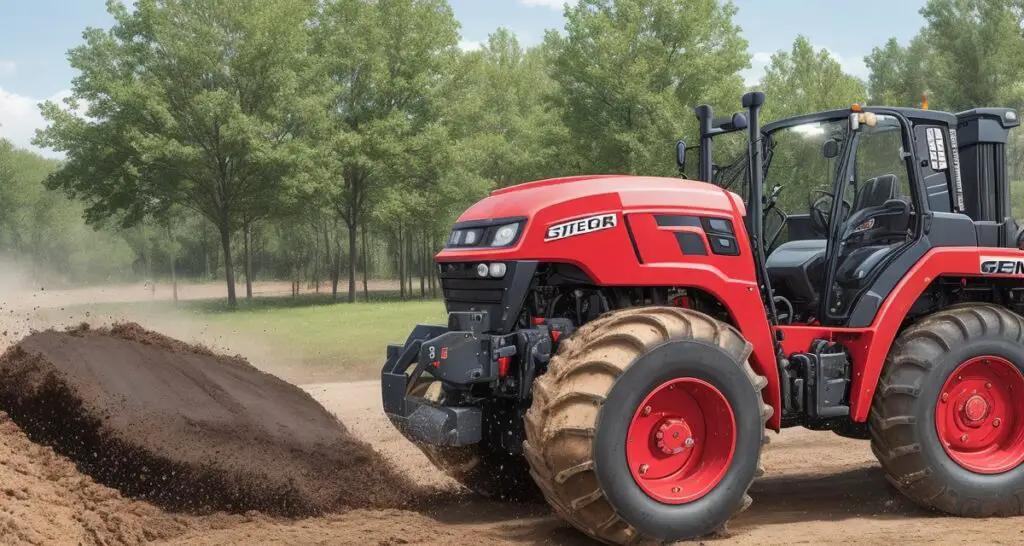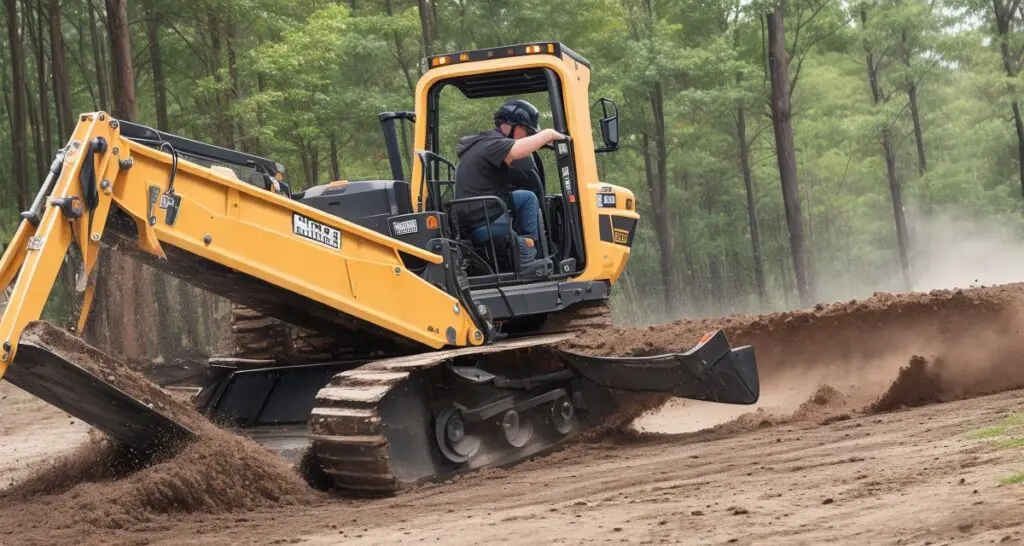Skid steers are amazing, multipurpose instruments that have completely changed how we approach certain activities. These small marvels are prized for their flexibility because they may be used in a variety of settings, including gardening, building, and landscaping. They can handle a variety of attachments to expertly handle various duties. Think of them as the Swiss Army knives of heavy apparatus. But have you ever wondered, “HOW MUCH DOES SKID STEER WEIGH?” Well, let’s dive into the weighty details of these versatile machines!
amidst their versatility, there’s one crucial detail that often goes unnoticed but holds significant importance – a skid steer’s weight. Understanding the weight of these machines is like knowing the key to unlocking their full potential and ensuring safe and efficient operation. In this blog post, we’ll delve into why knowing a skid steer’s weight is essential and explore the factors that contribute to its overall mass. So, let’s embark on this journey to discover the significance of that simple number on a skid steer’s specification sheet.
Factors Affecting Skid Steer Weight

Engine Type and Size:
Skid steers come equipped with various engine types and sizes. The weight of a skid steer can significantly vary depending on the engine it uses. Compact skid steers typically feature smaller engines, which are lighter, while larger and more powerful skid steers may have bigger engines that contribute to their heavier weight. This aspect is essential to consider when choosing a skid steer, as it affects not only the machine’s weight but also its performance and fuel efficiency.
Hydraulic Systems:
The hydraulic systems within a skid steer play a vital role in determining its weight. Skid steers rely on hydraulic components for their operations, such as lifting and moving heavy loads. Different skid steer models may have hydraulic systems of varying sizes and complexities, which can impact their overall weight. Understanding the hydraulic system’s design and capacity is essential, as it affects the skid steer’s performance, lifting capabilities, and weight.
Attachments and Accessories:
Skid steers are highly versatile machines, and their weight can be influenced by the types of attachments and accessories they’re designed to accommodate. Attachments like buckets, forks, and grapples can add extra weight to the skid steer. Some skid steers are designed to handle a wide range of attachments, while others may have a specific purpose, influencing their overall weight. It’s crucial to consider the intended use and the compatibility of attachments when evaluating a skid steer’s weight.
Cab Design and Materials:
The cab of a skid steer, where the operator sits, is another factor that contributes to its weight. Cab designs and materials can vary among different skid steer models. Some cabs are designed with comfort and safety in mind, featuring advanced materials and ergonomic layouts, which can increase the overall weight of the machine. Understanding the cab’s design and materials is important for operators, as it impacts their comfort and productivity during long working hours, as well as the skid steer’s total weight.
Standard Skid Steer Weight Range

Typical Weight Range for Compact Skid Steers:
Compact skid steers are renowned for their maneuverability and versatility. These nimble machines typically fall within a weight range of 2,000 to 7,000 pounds (approximately 907 to 3,175 kilograms). Their compact size allows them to work efficiently in tight spaces while being light enough for easy transport on trailers. Compact skid steers are favored for landscaping, construction, and agricultural tasks where a lighter footprint is essential.
Weight Range for Larger, Heavy-Duty Skid Steers:
On the other end of the spectrum, heavy-duty skid steers are the workhorses of the industry. They boast a weight range that often exceeds 7,000 pounds, with some models tipping the scales at 10,000 pounds or more. These robust machines are designed to handle more demanding applications, such as excavation, demolition, and material handling. Their greater weight contributes to stability and increased lifting capacity.
Variability Based on Different Manufacturers:
When it comes to skid steer weight, there’s no one-size-fits-all answer. Manufacturers offer a wide array of skid steer models, each with its unique specifications. The weight of a skid steer can vary considerably based on the make and model. Caterpillar, Bobcat, John Deere, and other well-known manufacturers all produce skid steers, and their weights may differ even within the same category. This variation allows buyers to choose a skid steer that best suits their specific needs, whether it’s a lighter compact model or a heavier-duty machine. Be sure to consider the manufacturer’s specifications when selecting a skid steer for your particular job requirements.
Mini Skid Steers: A Lightweight Alternative

Introduction to Mini Skid Steers:
Mini skid steers, often affectionately referred to as “compact powerhouses,” are a downsized version of their larger counterparts, designed for specific tasks that demand agility and versatility. These pint-sized machines have become increasingly popular in various industries due to their unique features and applications.
Comparison of Mini Skid Steer Weights with Standard Models:
When it comes to weight, mini skid steers are like the nimble gymnasts of the skid steer world. They typically weigh considerably less than standard skid steers. To put it into perspective, a standard skid steer might tip the scales at thousands of pounds, whereas mini skid steers are relatively feather-light.
Advantages and Limitations of Mini Skid Steers:
Mini skid steers bring a host of advantages to the table. Their reduced weight allows for better maneuverability and lower ground pressure, making them ideal for sensitive or compact spaces. These little dynamos can tackle a variety of tasks, from landscaping to construction, with ease. However, their smaller size does come with limitations, including reduced lifting capacity and power when compared to their larger counterparts. It’s all about finding the right balance between size and capability for your specific needs.
Heavyweight Skid Steers: When Size Matters

Overview of Heavy-Duty Skid Steers:
Heavy-duty skid steers are robust and powerful machines designed to handle more demanding tasks compared to their compact counterparts. These skid steers are built with durability and strength in mind, making them reliable workhorses on job sites where heavy lifting and rugged terrain are common.
Key Features That Increase Their Weight:
The weight of heavy-duty skid steers can be attributed to several key features that enhance their performance and durability. These features include:
- Larger Engines: Heavy-duty skid steers are equipped with bigger, more powerful engines, which add to their overall weight.
- Reinforced Structures: To withstand heavy loads and tough conditions, these skid steers have reinforced frames and chassis, which contribute to their weight.
- Enhanced Hydraulics: The hydraulic systems in heavy-duty skid steers are designed for higher pressure and flow, requiring more substantial components that increase their weight.
Applications Where Heavy Skid Steers Excel:
Heavy-duty skid steers shine in various applications due to their weight and powerful features. They excel in:
- Construction Sites: Heavy skid steers are ideal for tasks like lifting heavy construction materials, excavating, and demolishing structures.
- Agriculture: Their weight and power make them well-suited for agricultural operations, including digging, plowing, and handling large hay bales.
- Landscaping: Heavy skid steers can effortlessly move and grade soil, making them valuable for landscaping projects, especially in large yards or parks.
- Forestry: In forestry applications, heavy skid steers are used for moving and processing logs, as their weight aids in stability and control.
These skid steers are versatile and adaptable, making them valuable assets in industries that demand substantial power and durability.
Measuring and Weighing a Skid Steer
HOW MUCH DOES SKID STEER WEIGH?

Methods for Determining a Skid Steer’s Weight:
When it comes to finding out the weight of a skid steer, there are a few reliable methods you can employ. These methods are essential for ensuring the smooth operation and safe transport of your skid steer. Here’s how you can do it:
- Manufacturer Specifications: The most straightforward method is to check the manufacturer’s specifications. Typically, you can find a sticker or a plate on the skid steer that provides details, including its weight. This is often the most accurate source of information.
- Weighing Scales: For a precise measurement, using a certified weighing scale is a great option. Drive your skid steer onto the scale, and the weight will be displayed on the scale’s readout. This method is particularly helpful if you’ve made modifications or added attachments, as it gives you the current weight.
- Consult the Manual: Skid steer manuals often contain information about the machine’s weight. This is a quick and easy way to get a ballpark figure, especially if you’ve lost the manufacturer’s plate.
Importance of Accurate Weight Information for Transport and Operation:
Understanding and having accurate weight information for your skid steer is not just a technicality; it’s a critical factor for both safety and efficiency. Here’s why it matters:
- Safe Transport: When you’re transporting a skid steer on a trailer, knowing its weight is crucial. Overloading a trailer can be dangerous, and it may also lead to legal issues. Accurate weight information ensures you choose the right trailer and comply with regulations.
- Stability and Operation: The weight of your skid steer affects its stability and maneuverability, especially when lifting heavy loads or operating on uneven terrain. Incorrect weight estimates can lead to accidents and damage to the equipment.
- Maintenance and Repairs: Accurate weight information is vital for maintaining and repairing your skid steer. It helps mechanics choose the right parts and make proper adjustments, ensuring the machine runs efficiently and lasts longer.
- Cost Management: In certain situations, such as renting equipment or calculating fuel costs, knowing the precise weight of your skid steer helps with cost management and planning.
having the correct weight information for your skid steer is more than just a technicality; it’s a fundamental aspect of safe and efficient operation. Whether for transport, operation, maintenance, or cost considerations, knowing the accurate weight of your skid steer is indispensable.
Skid Steer Weight and Trailer Requirements

Understanding Trailer Weight Capacity
When it comes to transporting your skid steer, it’s crucial to understand the trailer’s weight capacity. The weight capacity of a trailer refers to the maximum load it can safely carry. Knowing this capacity ensures the safety of your skid steer and everyone involved. Different trailers have varying weight limits, so it’s essential to check your specific trailer’s specifications to match the weight of your skid steer accordingly.
How a Skid Steer’s Weight Affects Trailer Selection
Your skid steer’s weight plays a pivotal role in selecting the right trailer. The trailer you choose must not only accommodate the skid steer’s weight but also leave some margin for additional equipment or attachments. By considering your skid steer’s weight, you can avoid overloading the trailer, which can lead to safety issues and potential damage. Matching your skid steer’s weight with the appropriate trailer ensures a mode of secure and efficient transport.
Legal and Safety Considerations for Transporting Skid Steers
Transporting skid steers isn’t just about matching weight; it also involves legal and safety considerations. Depending on your location, there may be regulations and laws regarding the transport of heavy machinery. Ensure you are aware of and adhere to these regulations. Safety is paramount, so securing your skid steer properly on the trailer, using the correct tie-down methods, and ensuring proper visibility while driving are all crucial aspects of a safe journey. Always prioritize the safety of yourself, others on the road, and the integrity of your skid steer during transport.
CONCLUSION
In the conclusion of our exploration into skid steer weights, we’ll sum up the key takeaways and highlight the significance of considering a skid steer’s weight when it comes to both procurement and operation. Remember, the weight of a skid steer isn’t just a number; it plays a crucial role in ensuring safety, efficiency, and the overall success of your projects. So, before you make any decisions, we encourage you to delve deeper into the specific skid steer models and their respective weights to ensure you have the right equipment for the job. Thanks for reading, and we hope this information proves valuable in your skid steer endeavors!
FAQ:
How much does the average skid steer weigh?
The average weight of a skid steer typically falls within the range of 6,000 to 8,000 pounds (2,700 to 3,600 kilograms) for compact models, while larger and heavy-duty skid steers can weigh between 8,000 to 10,000 pounds (3,600 to 4,500 kilograms). Keep in mind that these figures can vary depending on the manufacturer and specific model.
Why is it important to know the weight of a skid steer?
Understanding a skid steer’s weight is essential for several reasons. It helps in selecting the right trailer for transportation, ensures safe operation, and allows for compliance with legal weight restrictions. Additionally, it influences the machine’s performance and suitability for various tasks.
How can I measure or weigh my skid steer?
To measure or weigh a skid steer, you can use specialized equipment like a skid steer scale or weighbridge, which provides accurate results. Alternatively, you can estimate the weight by referring to the manufacturer’s specifications or consulting with a certified technician for a more precise measurement.
Are there lightweight alternatives to standard skid steers?
Yes, there are lightweight alternatives in the form of mini skid steers. These compact machines are designed to be smaller and lighter than their standard counterparts, making them ideal for specific applications where weight is a concern. Mini skid steers typically weigh between 1,500 to 3,000 pounds (680 to 1,360 kilograms).
How does a skid steer’s weight affect its transport on a trailer?
A skid steer’s weight significantly influences the type of trailer required for transport. It’s essential to choose a trailer with a weight capacity that exceeds the skid steer’s weight to ensure safe and legal transportation. Overloading a trailer can lead to safety hazards and potential legal issues, so understanding the skid steer’s weight is crucial for proper trailer selection.

